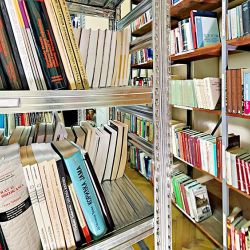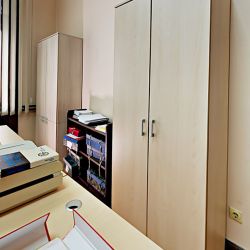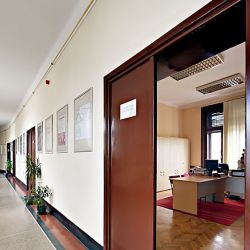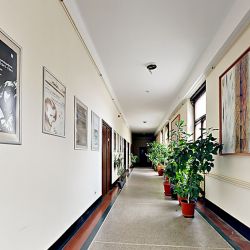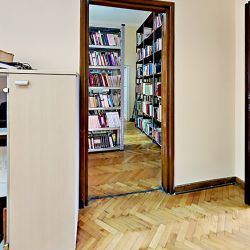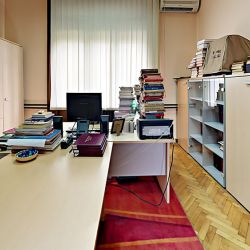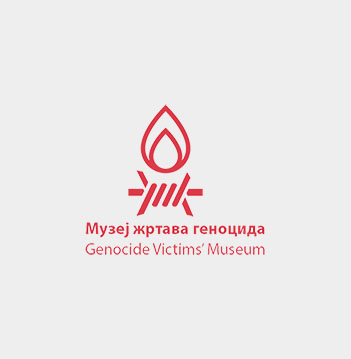
MUZEJ ŽRTAVA GENOCIDA
Muzej žrtava genocida je referentna ustanova kulture od nacionalnog značaja.
U pitanju je institucija jedinstvena, ne samo na području Republike Srbije, već i čitave jugoistočne Evrope.
Muzej je osnovala Narodna skupština Republike Srbije 1992. godine radi trajnog sećanja na žrtve genocida počinjenog nad Srbima, prikupljanja, obrade i korišćenja podataka o njima i ostvarivanju obaveza iz Međunarodne konvencije o sprečavanju i kažnjavanju zločina genocida. Muzej se, istovremeno, bavi i prikupljanjem, obradom i korišćenjem podataka o Holokaustu i Samudaripenu.
Usvajanjem Zakona o muzejskoj delatnosti u oktobru 2021. godine, Muzej je postao matični muzej u Republici Srbiji za negovanje kulture sećanja na žrtve genocida i holokausta.
Zadaci:
Muzej prikuplja, obrađuje i čuva: podatke o pojedinačnim i grupnim žrtvama zločina genocida i drugim genocidnim činjenicama; građu o zločinu genocida, službena dokumenta, spiskove, svedočenja, muzejske eksponate, fotografije, filmove, video i tonske snimke, knjige, medicinsku i drugu dokumentaciju i dr; podatke od značaja za utvrđivanje organizatora, izvršilaca zločina, naredbodavaca i saučesnika odgovornih za učinjene zločine genocida; podatke o spasiocima žrtava genocida; utvrđuje i radi na obeležavanju mesta stradanja (logora, jama, stratišta žrtava); obezbeđuje korišćenje kulturno-istorijske građe i saznanja kojim raspolaže u kulturne, obrazovne, vaspitne, informativne i druge svrhe putem izlaganja ove građe u okviru stalnih i povremenih izložbi, publikovanja i na drugi način čineći ih dostupnim javnosti; sarađuje sa srodnim institucijama u zemlji i inostranstvu.
Dokumentacija koja se nalazi u Muzeju svojim sadržajem odnosi se, pored zločina genocida, i na ratne zločine, etnička čišćenja, stratišta, jame, logore, zatvore, prinudna raseljavanja, pokrštavanja, uzimanje talaca, prinudni rad, pljačku i uništavanje imovine, kulturno-istorijskih i verskih spomenika, upotrebu nedozvoljenih sredstava u borbi.
Muzej kao najznačajnije datume obeležava 22. april i 21. oktobar koji su i državni praznici u Republici Srbiji i koji imaju veliki značaj u kulturi sećanja na žrtve Drugog svetskog rata.
Kao Dan sećanja na žrtve genocida počinjenog nad Srbima, kao i na žrtve Holokausta i Samudaripena, još 1992. godine članom 2. Zakona o osnivanju Muzeja žrtava genocida ustanovljen je 22. april - dan proboja zatočenika sistema koncentracionih i logora smrti NDH u Jasenovac 1945. godine, koji je postojao od avgusta 1941. do 22. aprila 1945. godine. Jasenovačko gubilište predstavljao je najveći logor i stratište na prostoru okupirane Jugoslavije u Drugom svetskom rat. Time je Republika Srbija postala prva zemlja u svetu koja je, znatno pre nego što je Generalna skupština Ujedinjenih nacija 2005. godine usvojila Rezoluciju o uspostavljanju Međunarodnog dana sećanja na žrtve Holokausta, ustanovila svoj nacionalni dan sećanja.
Zakonom o izmenama i dopunama zakona o državnim i drugim praznicima u Republici Srbiji 22. april istovremeno je utvrđen i kao državni praznik sa statusom dana sećanja.
Istim Zakonom o izmenama i dopunama zakona o državnim i drugim praznicima u Republici Srbiji ustanovljen je kao državni praznik i Dan sećanja na srpske žrtve u Drugom svetskom ratu, u znak sećanja na ratni zločin masovnog streljanja – odmazde nam civilnim stanovništvom Kragujevca i okoline koje su izvršile nemačke okupacione snage 21. oktobra 1941. godine.
Najznačajnija aktivnost:
Muzej žrtava genocida raspolaže bazom podataka žrtava Drugog svetskog rata, državljana Kraljevine Jugoslavije, koja u ovom trenutku sadrži oko 660 000 imena i prezimena žrtava. Ova aktivnost realizuje se kao revizija Popisa „Žrtve rata 1941-1945“ iz 1964. godine. Cilj ove aktivnosti je poimenično utvrđivanje žrtava Drugog svetskog rata sa područja tada okupirane Kraljevine Jugoslavije (1941-1945) i to sa punom identifikacijom, bez obzira na nacionalnu, versku, etničku, ideološku i vojno-formacijsku pripadnost.
Delatnost:
Deo muzejskih zbirki je u kontinuiranom procesu prinovljavanja, obrade i digitalizacije.
Muzej je do sada objavio više od 180 naučnih monografija, realizovao više od 30 izložbi koje su predstavljene u Republici Srbiji i regionu, na prostorima nekadašnje Jugoslavije. Neke od izložbi Muzeja predstavljene su u Italiji, Francuskoj i Velikoj Britaniji.
Muzej je realizovao nekoliko projekata čiji su rezultat bili dokumentarni i dokumentarno-igrani filmovi o logorima u Jasenovcu, na Starom Sajmištu, o streljanju civila u Kragujevcu oktobra 1941. godine...
Muzej ima dugogodišnju plodotvornu saradnju sa referentnim nacionalnim ustanovama u oblasti kulture, prosvete, nauke i umetnosti u Republici Srbiji i inostranstvu, kao i sa Srpskom pravoslavnom crkvom.
Posebnu pažnju stručnjaci Muzeja posvećuju realizaciji brojnih programa u oblasti naučno-istraživačkog rada, kulture, prosvete, kulture sećanja, umetnosti, izdavaštva i informisanja na celokupnom području Republike Srbije, kao i u inostranstvu.
Muzej ima specijalizovanu biblioteku sa bezmalo 10 000 naslova monografskih i serijskih publikacija.
Muzej se bavi naučno-istraživačkim radom. Stručnjaci u Muzeju, kao i brojni saradnici, ostvarili su najviše rezultate u nauci. Objavljuju radove u najznačajnijim naučnim časopisima, učestvuju na domaćim i stranim naučnim skupovima, konferencijima, okruglim stolovima…
Muzej ostvaruje značajnu međunarodnu saradnju kroz učešće u brojnim projektima i drugim aktivnostima.
Počev od 2022. godine, Muzej je, pored ostalog, dobio i funkciju Nacionlane kancelarije Republike Srbije za saradnju sa IHRA (International Holocaust Remembrance Alliance).
Muzej je predstavljen i u brojnim medijima (televizija, radio, štampa, internet portali). Ova saradnja se ostvaruje kroz gostovanja, izjave, razgovore, intervjue… Stručnjaci Muzeja su često angažovani kao konsultanti na realizaciji najznačajnih projekata u medijima. Naročito je značajna saradnja u projektima javnog servisa, Radio-televizije Srbije.
Muzej je navedene rezultate rada, koji prevazilaze domete malog broja stručnjaka angažovanih u samoj ustanovi, ostvario za svega tri decenije postojanja.
U prethodne dve godine, država je prepoznala značaj Muzeja što je vidljivo kroz povećanje broja stalno zaposlenih i stručnih saradnika i povećanje finansijskih sredstava za realizaciju programa rada i drugih projekata Muzeja, koje on obavlja samostalno ili u saradnji sa drugim institucijama, ustanovama, organizacijama i pojedincima.
Povodom obeležavanja jubilarne 30. godišnjice Muzeja žrtava genocida, predsednik Republike Srbije g. Aleksandar Vučić odlikovao je ovu ustanovu kulture od nacionalnog značaja Zlatnom medaljom za zasluge za Republiku Srbiju.
Zbirke i fondovi:
Muzej ima više od 15 ličnih fondova sa 52 000 dokumenata i 40 000 skeniranih jedinica dokumentarne građe. Muzej raspolaže i sa više od 230 arhivskih kutija sa 200 000 dokumenata iz perioda Drugog svetskog rata i ratova za jugoslovensko nasleđe (1991-1999), zbirkom dokumentarnih fotografija sa više od 20 000 fotografija, zbirkom digitalne arhivske građe (sa oko 1 500 000 jedinica), zbirkom video i audio zapisa sa više od 200 sati materijala (400 CD/DVD).
- Muzej ima značajne zbirke umetničkih dela, predmeta, vatrenog i hladnog oružja.
- Muzej poseduje originalna dokumenta i predmete logoraša iz logora u NDH.
I. Zbirke:
II. Lični fondovi:

THE GENOCIDE VICTIMS’ MUSEUM
The Genocide Victims’ Museum is a referential cultural institution of national importance.
The institution is unique, not only in the territory of the Republic of Serbia, but also in the whole of Southeast Europe.
The museum was founded by the National Assembly of the Republic of Serbia in 1992 for the permanent remembrance of the victims of the genocide committed against the Serbs, to collect, process and use data about them, and to fulfil obligations from the Convention on the Prevention and Punishment of the Crime of Genocide. At the same time, the museum deals with the collection, processing and use of data on the Holocaust and Samudaripen.
With the adoption of the Law on Museum Activity in October 2021, the Genocide Victims’ Museum became the main museum in the Republic of Serbia for fostering the culture of remembrance of victims of genocide and the Holocaust.
Task:
The Museum collects, processes and stores: data on individual and group victims of the crime of genocide and other genocidal facts; material on the crime of genocide, official documents, lists, testimonies, museum exhibits, photographs, films, video and audio recordings, books, medical and other documentation, etc; the relevant data for determining the organizers, perpetrators of crimes, commanders and accomplices responsible for committed crimes of genocide; data on rescuers of victims of genocide; determines and works on marking places of suffering (camps, pits, execution grounds of victims); ensures the use of cultural-historical material and knowledge at its disposal for cultural, educational, pedagogical, informational and other purposes by exhibiting this material in the framework of permanent and periodical exhibitions, publishing and otherwise making them accessible to the public; cooperates with related institutions in the country and abroad.
In addition to the crime of genocide, the documentation kept in the Museum refers to war crimes, ethnic cleansing, execution grounds, pits, camps, prisons, forced displacements, forced conversions, hostage-taking, forced labor, looting and destruction of property, cultural and historical and religious monuments, the use of illicit means of warfare.
The museum observes the 22nd of April and 21st of October as the most important dates, which are the public holidays in the Republic of Serbia and which have great importance in the remembrance culture of the victims of the Second World War.
Back in 1992, pursuant to Article 2 of the Law on the Establishment of the Museum of Genocide Victims, the Day of Remembrance of the Victims of the Genocide committed against Serbs, as well as the victims of the Holocaust and Samudaripen, was determined to be 22nd of April - the day of the breakthrough of prisoners of the NDH system of concentration and death camps in Jasenovac in 1945, which existed from August 1941 to 22nd April 1945. The Jasenovac killing site was the largest concentration camp and execution ground on the territory of occupied Yugoslavia during World War II. Thus, the Republic of Serbia became the first country in the world to establish its own public day of remembrance, well before the General Assembly of the United Nations adopted the Resolution on the establishment of the International Day of Remembrance for the Victims of the Holocaust in 2005.
The Law on Amendments to the Law on State and Other Holidays in the Republic of Serbia established the 22nd of April as a public holiday with the status of a remembrance day.
By the same Law on Amendments to the Law on State and Other Holidays in the Republic of Serbia, the Day of Remembrance of Serbian Victims in the World War II was established as a state holiday, in the memory the war crime of mass shooting - retaliation against the civilian population of Kragujevac and its surroundings perpetrated by the German occupation forces on 21st of October 1941.
The most significant activity:
The Genocide Victims’ Museum has a database of victims of World War II, citizens of the Kingdom of Yugoslavia, which currently contains about 660,000 names and surnames of the victims. These activity is being implemented as a revision of the census “Victims of the War 1941-1945“ from 1964. The aim of this activity is to identify by name the victims of World War II from the territory of the then occupied Kingdom of Yugoslavia (1941-1945) with full identification, regardless of national, religious, ethnic, ideological and military affiliation.
The work:
The part of the Museum’s collections is in the continuous process of renewal, processing and digitization.
The museum has so far published more than 180 scientific monographs, realized more than 30 exhibitions that were displayed in the Republic of Serbia and the region, in the former Yugoslavia. Some of the Museum’s exhibitions were displayed in Italy, France and Great Britain.
The museum realized several projects, the result of which were documentaries and documentary-fiction films about the camps in Jasenovac, at Stari Sajmiste, about the shooting of civilians in Kragujevac in October 1941…
The museum has a long-standing fruitful cooperation with referential national institutions in the field of culture, education, science and art in the Republic of Serbia and abroad, as well as with the Serbian Orthodox Church.
The experts of the Museum devote special attention to the implementation of numerous programs in the field of scientific research, culture, education, remembrance culture, art, publishing and informing in the entire territory of the Republic of Serbia, as well as abroad.
The Museum has a specialized library with nearly 10,000 titles of monographs and serial publications.
The Museum is engaged in scientific and research work. Experts of the Museum, as well as numerous collaborators, have achieved the highest results in science. They publish papers in the most important scholarly journals, participate in domestic and foreign scientific gatherings, conferences, round tables...
The Museum achieves significant international cooperation through participation in numerous projects and other activities.
As of 2022, the Museum has, among other things, been given the role of the National Office of the Republic of Serbia for the Cooperation with the IHRA (International Holocaust Remembrance Alliance).
The Museum is present in numerous media (television, radio, press, internet portals). This cooperation is realized through guest appearances, statements, conversations, interviews... Museum’s experts are often engaged as consultants on the realization of the most important projects in the media. Cooperation in the projects of the public broadcaster, the Radio Television of Serbia, is particularly significant.
The museum has achieved the aforementioned results, which exceed the scope of a small number of experts engaged in the institution itself, in just three decades of existence.
In the previous two years, the state has recognized the importance of the Museum, which is visible through the increase in the number of permanent employees and expert associates and the increase in financial resources for the implementation of the Museum’s work program and other projects, which it carries out independently or in cooperation with other institutions, organizations, and individuals.
On the occasion of the commemoration of the 30th anniversary of the Genocide Victims’ Museum, the President of the Republic of Serbia Mr. Aleksandar Vučić awarded this cultural institution of national importance with the Gold Medal of Merit to the Republic of Serbia.
Collections and funds:
The museum has more than 15 personal funds with 52,000 documents and 40,000 scanned units of documentary material. The museum also has more than 230 archive boxes with 200,000 documents from the period of the World War II and the wars of Yugoslav succession (1991-1999), a collection of documentary photographs with more than 20,000 photographs, a collection of digital archival materials (with about 1,500,000 units), a collection of video and audio recordings with more than 200 hours of material (400 CDs/DVDs).
- The museum has significant collections of works of art, objects, firearms and cold weapons.
- The museum has original documents and objects of inmates from the NDH camps.
 Ћирилица
Ћирилица  Latinica
Latinica 

